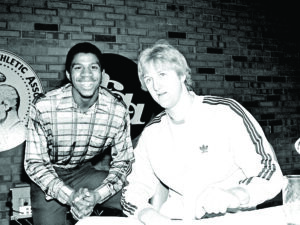By David Mullens
On November 25, announcer Gus Johnson of Fox opened the national college football game of the week broadcast with the type of hyperbole that both he and his network are known for.

Photo courtesy of Sports History Weekly
“I hope you’re ready to watch the biggest game of the season,” Johnson cried. “It’s the world-famous Ohio State Buckeyes and the Michigan Wolverines. The stakes could not be higher, and the ‘hate’ is at an all-time high.”
Actually, the stakes could be a lot higher. Has Johnson ever seen “Ben Hur?” Only in today’s America is “hate” touted as a product benefit. Sounds like all of the love and togetherness promoted as principles during Thanksgiving weekend lasted two days.
“It’s do or die. [Michigan and Ohio State] are ready to play in the greatest rivalry in sports.” Johnson seemed hellbent on selling a game college football fans were already going to watch. “The Game,” as it is referred to, pitted two 11-0 teams ranked No. 2 and No. 3 against each other. A victory gave the winner a chance at the Big 10 title and a bid to vie for the National Championship. Michigan won 30-24.
It was the biggest game of the 2023 college football season so far. I get that. But is Ohio State versus Michigan “the greatest rivalry in sports?” Let’s look at team rivalries, which eliminates from the discussion past individual competitions like Chris Evert versus Martina Navratilova in tennis, Arnold Palmer versus Jack Nicklaus in golf and boxing’s Muhammad Ali versus Joe Frazier.
What about the New York/San Francisco Giants versus Brooklyn/Los Angeles Dodgers? It’s a rivalry that goes back to 1890, heightened during the days when the Manhattan’s Polo Grounds Elites waged war against the Brooklyn’s Ebbets Field Bums, before the young men headed west. In 1951, the two teams played in the “Shot Heard ‘Round the World” game.
On both coasts, they have faced off more than 2,500 times. Wikipedia states that the Giants and Dodgers “is regarded as one of the fiercest and longest-standing rivalries in American baseball, with some observers considering it the greatest sports rivalry of all time.”
What about the New York Yankees and Boston Red Sox? The rivalry spans more than 120 seasons and includes the “Curse of the Bambino” and the Pedro Martinez takedown of bench coach Don Zimmer 20 years ago. Wikipedia also states that the Yankees and Red Sox “have developed what is arguably the fiercest rivalry in all of American sports.”
You’ve got questions? Wikipedia’s got two answers.
In the 1960s and 1980s, the Los Angeles Lakers and Boston Celtics rivalry was real, whether it was Wilt Chamberlain versus Bill Russell or Magic Johnson against Larry Bird. What about Army versus Navy? They have played against each other since 1890. Texas and OU? Harvard and Yale? Iowa and Iowa State? The Michigan and Ohio State rivalry may be big in Traverse City and Toledo, but does it play in Tuscaloosa?
“A rivalry has to consist of two teams that are good,” said former The Dallas Morning News sportswriter Gary Myers, author of many sports books including How ‘Bout Them Cowboys?: Inside the Huddle with the Stars and Legends of America’s Team and the recently published Once a Giant: A Story of Victory, Tragedy, and Life After Football. “It doesn’t get a lot of emotion going if one team is always winning.”
Myers lived in Dallas when the Cowboys had one clear rival. “When I lived in Dallas in the 1980s, I always thought that the Cowboys’ biggest rival was Washington. Even when the [New York football] Giants got good around 1984, I still felt it was — as we knew them then — the Redskins.”
Regionality plays a key role in building a rivalry, although Ann Arbor, Mich. and Columbus, Ohio are 200 miles and two states apart. People will say that the Big Game between Cal and Stanford with the defining “The Play” or the Iron Bowl between Alabama and Auburn and the eternal “Kick-Six” highlight are bigger rivalries.
The Green Bay Packers and Chicago Bears have played against each other more than 200 times. In college basketball, no game approaches Duke versus North Carolina.
Locally, the Mavericks and Stars don’t have any true rivals. The Rangers never had a rival — it is tough to build animosity toward Seattle or Anaheim — although, after the 2023 ALCS, the Houston Astros show signs of becoming their frightful foe. Both teams share a state (Texas), the matchup has a time-tested storyline of good (the amiable Rangers) versus evil (the cheating Astros), and both teams should be competitive for a long time.
I have always maintained that the Yankees and Red Sox clash is the greatest rivalry in sports. “A couple of years ago, the schedule was set up so that they played 19 times,” Myers, now living in New York, said. “By the time it gets to September, both teams are out of it. In baseball, the rivalry becomes apparent in the playoffs when the season is on the line.
“I think that the reason football rivalries are so cool is that they only happen once a year. I don’t think I am going to agree with you [regarding ‘The Game’]. It’s hard to quantify, but I think [Michigan versus Ohio State] is the biggest rivalry,” Myers said, with the caveat that his son graduated from Michigan in 2017.
Nationally, “The Game” is the most-watched college football game of the regular season. Last year, Michigan and Ohio State drew 17.14 million viewers, virtually the same numbers as the National Championship game.
So, I suppose that Michigan and The Ohio State University is “the greatest rivalry in sports.” I just “hate” — in Gus Johnson’s words — to admit that he is right.
